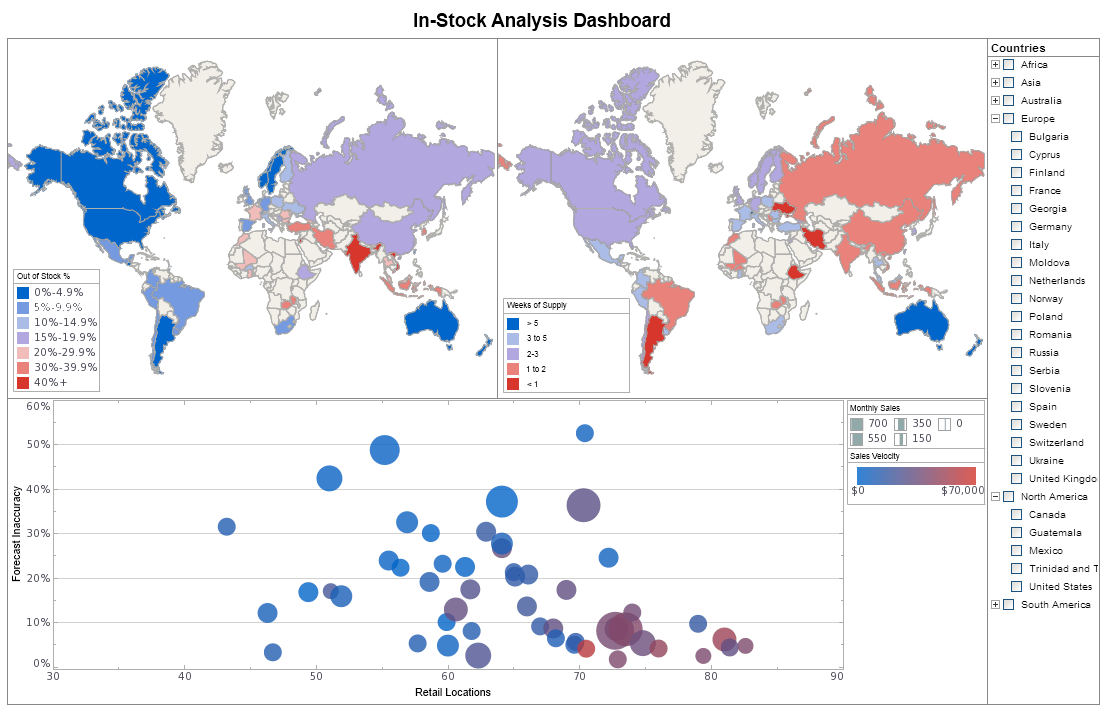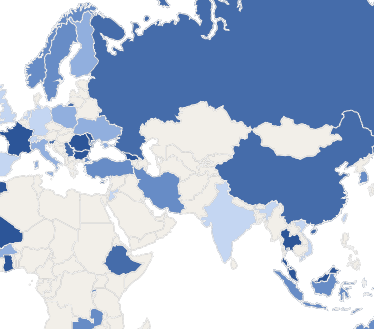Evaluate InetSoft's Agile Business Intelligence Software
InetSoft's agile business intelligence software provides end-users with data mashups and interactive visualizations in its Web-based BI platform. How is InetSoft's solution agile? First, it provides:
Maximum Self-Service:
- Ad hoc reporting tools use a drag-and-drop interface based on simplified data models you choose.
- Visualization techniques of highly interactive dashboards encourage and facilitate data exploration through multi-dimensional charting styles and point and click filtering and sorting
- End-user defined data mashup enables business users or analysts to combine data from disparate sources, including imported spreadsheets, without the need for formal data models being pre-defined, and share the mashup in the BI environment.
 |
View a 2-minute demonstration of InetSoft's easy, agile, and robust BI software. |
Flexible Adaptation:
- Changing data structures are automatically recognized.
- No ETL process is necessary to aggregate operational data.
- If using ETL, the application facilitates quick and easy experimentation with new dashboards or reports using new data models which can later be codified in ETL processes when ready.
Data Mashups:
- New data sources can be added rapidly and combined with disparate data source types.
- End-user defined data mashup is possible, a capability that is unique to InetSoft's solution.
About InetSoft
Since 1996 InetSoft has been delivering easy, agile, and robust business intelligence software that makes it possible for organizations and solution providers of all sizes to deploy or embed full-featured business intelligence solutions. Application highlights include visually-compelling and interactive dashboards that ensure greater end-user adoption plus pixel-perfect report generation, scheduling, and bursting.
InetSoft's patent pending Data Block™ technology enables productive reuse of queries and a unique capability for end-user defined data mashup. This capability combined with efficient information access enabled by InetSoft's visual analysis technologies allows maximum self-service that benefits the average business user, the IT administrator, and the developer. InetSoft solutions have been deployed at over 5,000 organizations worldwide, including 25% of Fortune 500 companies, spanning all types of industries.
How Are Agile Development Principles Applied to Business Intelligence?
Applying Agile development principles to Business Intelligence (BI) can enhance the effectiveness, flexibility, and responsiveness of BI projects. Here's how Agile principles are commonly applied in the context of Business Intelligence:
- Iterative and Incremental Development:
- Sprints for BI Development: BI projects are broken down into short development cycles or sprints, typically 2-4 weeks. Each sprint delivers a potentially shippable increment of the BI solution, allowing for continuous improvement and adaptability.
- User Involvement and Collaboration:
- Regular Stakeholder Feedback: Agile BI emphasizes continuous collaboration with end-users and stakeholders. Regular feedback loops ensure that the BI solution aligns with user expectations and evolving business needs.
- User Stories in BI Planning: Requirements are expressed as user stories in BI project planning. These stories articulate the business value and functionality expected by end-users, ensuring a user-centric approach.
- Adaptability to Change:
- Flexible BI Requirements: Agile BI accommodates changing requirements even late in the development process. This is crucial in BI projects where business needs and data sources may evolve, allowing the BI solution to adapt to emerging insights or shifts in business strategy.
- Cross-Functional Teams:
- Collaborative BI Teams: Agile BI teams are cross-functional, including members with expertise in data analysis, database design, data visualization, and domain knowledge. This ensures a holistic approach to BI development, where team members collaborate to deliver a comprehensive solution.
- Continuous Integration and Testing:
- Automated Testing in BI: Automated testing is crucial in BI projects to ensure the accuracy and reliability of data transformations and reporting. Continuous integration practices are applied to maintain a reliable and up-to-date BI environment.
- Prioritization Based on Business Value:
- Value-Driven BI Roadmap: BI features are prioritized based on their business value. Agile BI teams focus on delivering high-value capabilities early, providing immediate benefits to the business and allowing for a more strategic approach to feature development.
- Time-Boxed Delivery:
- Fixed Time Frames for BI Deliverables: Agile BI projects have fixed time frames (sprints) for delivery. This time-boxed approach ensures that BI solutions are delivered regularly, providing a predictable cadence for the business to expect and evaluate progress.
- Visibility and Transparency:
- BI Dashboards for Project Tracking: Agile BI teams often use BI dashboards to track project progress, key performance indicators (KPIs), and other relevant metrics. This transparency fosters trust and communication between the development team and stakeholders.
- Embracing Change:
- Change Management in BI: Agile BI embraces changes in requirements, technology, or business priorities. This is critical in the BI domain, where the landscape can evolve rapidly, and the ability to adapt ensures the continued relevance of the BI solution.
- Focus on Delivering Minimal Viable Product (MVP):
- Iterative BI Releases: Agile BI emphasizes the delivery of a minimal viable product in the early stages, allowing users to derive value quickly. Subsequent releases build on this foundation, incorporating additional features based on user feedback and evolving business needs.
- Retrospectives for Continuous Improvement:
- BI Project Retrospectives: After each sprint or project phase, Agile BI teams conduct retrospectives to reflect on what went well and what could be improved. This continuous improvement cycle ensures that the BI development process becomes more efficient over time.
More Articles About Agility
Collaborate on Performance Improvement - This brings me to my next point: how to collaborate on performance improvement with other business units in an organization. I personally would like to see more credit go to the things that are more on time and respectable than the negative aspects that get recognized. Part of that requires a governing body that's out to change the environment. We've heard...
Deliver Better Results For Our Customers - We use InetSoft's StyleBI in order to give our customers self-service interactive dashboards and reports of agricultural data through our branded web portal. This is a great improvement over customers having to call and email in to inquire about the status of orders and shipments. When our programmers are busy developing and adding to our core application, it doesn't make sense to take them away to build reports when there's a tool that allows...
Discussing the Business Intelligence Roadmap - Want to learn what is on the business intelligence roadmap? Read articles from InetSoft about BI technology trends generally and InetSoft's BI software development plans specifically: Case Study of Geographic Business Intelligence - Information workers at a county seat's administrative offices are detecting a rise in juvenile crime. Costs of policing are increasing, and insurance premiums and retail confidence are being affected. The staff is asked to understand the trends and try to discern the...
Electronic Transaction Management Business Intelligence - A brokerage firm wants to improve the speed and reliability of its web based electronic transaction system. To do so, it must first determine which counterparties encountered the greatest amount of latency and session rejections over the past two years, and the underlying cause in each instance...
Sports KPI Reporting Tools - Key Performance Indicator (KPI) reporting tools play a crucial role in professional sports organizations by helping them track and analyze various performance metrics to improve team performance, player development, and fan engagement. Here are some KPI reporting tools commonly used in professional sports: Sports Analytics Software: There are various sports analytics software platforms that cater to different needs, such as Catapult Sports and Sportscode. These tools allow teams to collect and analyze data on player performance, game strategy, and injury prevention...




